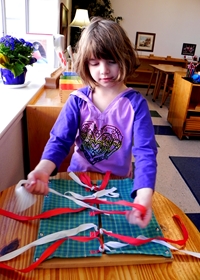The presentation that a classmate did in our Child Development and Learning Theories class on Maria Montessori provided me information about the Montessori Method of Education. This presentation discussed how Montessori did observational research on how children learn through exploration that they do naturally on their own. She observed that the child’s interests create a learning environment for them to develop and grow naturally. She felt that children need to be respected and held to the highest level. Her observations found that there are four planes of education. These planes are divided into the following age groups: zero to six, six to twelve, twelve to eighteen, and eighteen to twenty-four. That a sensitive period exists that allows children to absorb numerous amount of information that they learn from. The education method uses materials that are designed with correction of error to support children have proper learning outcomes.
This method of learning is important for me to understand as a future teacher of children. The use of manipulatives in the classroom will provide such corrective learning of error that Montessori’s theory of Method of Education represents.
An article that suggests how to incorporate the Montessori Theory of Education into a classroom that I felt would be helpful as a teacher is below:
Learning Materials link for full article
Montessori Learning Materials
You might see a 4-year-old boy forming words using 3-dimensional letters called “the movable alphabet.” A 2½ -year-old may be sitting by a teacher, ever-so-carefully pouring water from 1 tiny pitcher to another. Several children kneeling on the floor may be intently struggling over a puzzle map of South America.
Montessori Materials Are Appealingly Designed
Throughout the room, children will be sorting, stacking, and manipulating all sorts of beautiful objects made of a range of materials and textures. Many of these objects will be made of smooth polished wood. Others are made of enameled metal, wicker, and fabric. Also available to explore are items from nature, such as seashells and birds’ nests.
How can a preschool-aged child be trusted to handle fragile little items independently? Montessori teachers believe that children learn from their mistakes. If nothing ever breaks, children have no reason to learn carefulness. Children treasure their learning materials and enjoy learning to take care of them “all by myself.”
Montessori teachers make a point to handle Montessori materials slowly, respectfully, and carefully, as if they were made of gold. The children naturally sense something magical about these beautiful learning objects.
As children carry their learning materials carefully with 2 hands and do their very special “work” with them, they may feel like they are simply playing games with their friends—but they are actually learning in a brilliantly designed curriculum that takes them, 1 step at a time, and according to a predetermined sequence, through concepts of increasing complexity.
Ingenious 
Each learning material teaches just 1 skill or concept at a time. For example, we know that young children need to learn how to button buttons and tie bows. Dr. Montessori designed “dressing frames” for children to practice on.
The frame removes all distractions and simplifies the child’s task. The child sees a simple wooden frame with 2 flaps of fabric—1 with 5 buttonholes and 1 with 5 large buttons. His task is obvious. If he makes an error, his error is obvious.
Built-in “control of error” in many of the Montessori materials allows the child to determine if he has done the exercise correctly. A teacher never has to correct his work. He can try again, ask another child for help, or go to a teacher for suggestions if the work doesn’t look quite right.
Materials contain multiple levels of challenge and can be used repeatedly at different developmental levels. A special set of 10 blocks of graduated sizes called “the pink tower” may be used just for stacking; combined with “the brown stair” for comparison; or used with construction paper to trace, cut, and make a paper design. The pink tower, and many other Montessori materials, can also be used by older children to study perspective and measurement.
Montessori materials use real objects and actions to translate abstract ideas into concrete form. For example, the decimal system is basic to understanding math. Montessori materials represent the decimal system through enticing, pearl-sized golden beads.
Loose golden beads represent ones. Little wire rods hold sets of 10 golden beads—the 10-bar. Sets of 10 rods are wired together to make flats of 100 golden beads—the hundred square. Sets of 10 flats are wired together to make cubes of 1,000 golden beads—the thousand cube.
Later, because materials contain multiple levels of challenge, the beads can be used to introduce geometry. The unit is a point; the 10-bar is a line; the hundred square a surface; the thousand cube, a solid.
Montessori learning materials are ingeniously designed to allow children to work independently with very little introduction or help. The students are empowered to come into the environment, choose their own work, use it appropriately, and put it away without help.
No comments:
Post a Comment